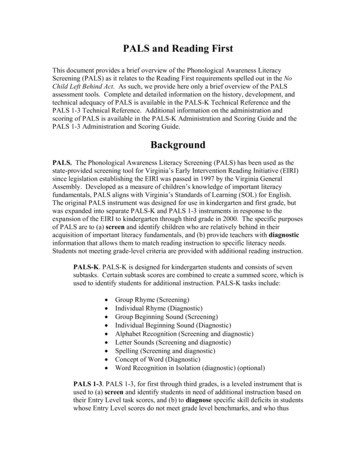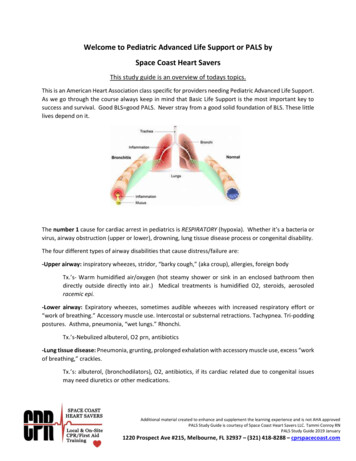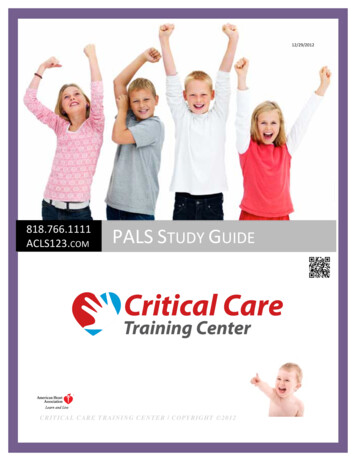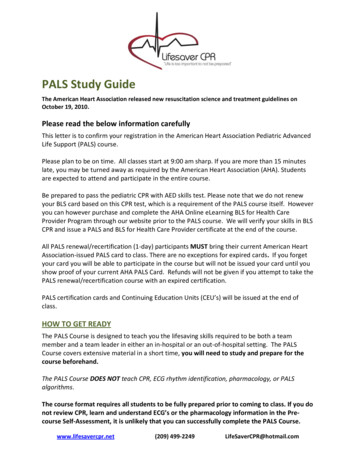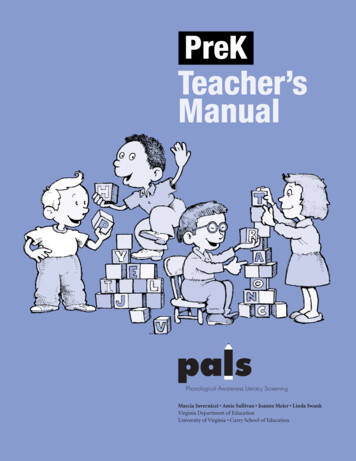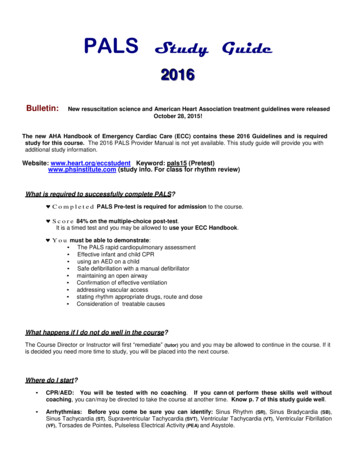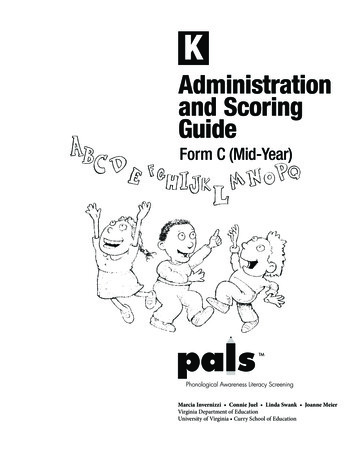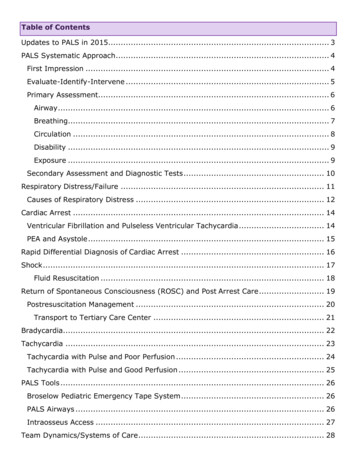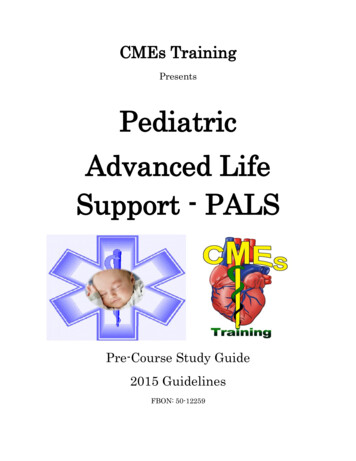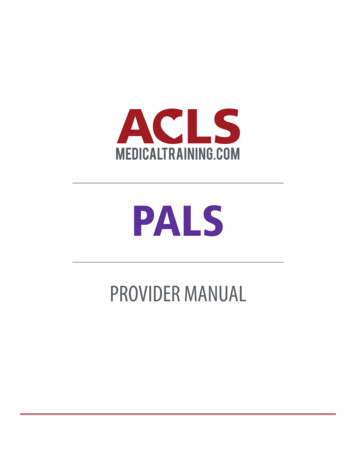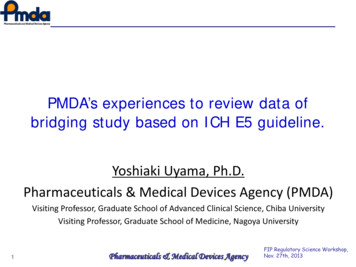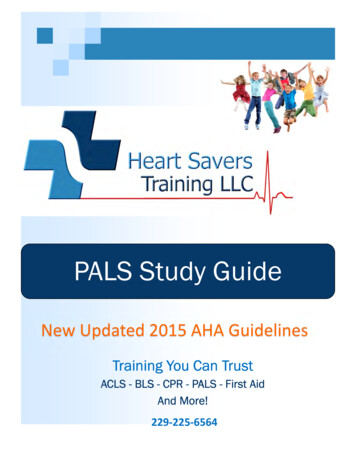
Transcription
PALS Study GuideNew Updated 2015 AHA GuidelinesTraining You Can TrustACLS - BLS - CPR - PALS - First AidAnd More!229-225-6564
Course OverviewThis study guide is an outline of content that will be taughtin the American Heart Associa on PALS (PediatricAdvanced Life Support) Course. It is intended tosummarize important content, but since all PALS contentcannot possibly be absorbed in a class given every twoyears, it should be the desire of every Healthcare Providerto con nuously study in order to provide Excellent &Compassionate Care to both the Pediatric Pa(ent as wellas providing support to the parents.This guide does not replace the Pediatric Advanced Life Support Provider Manual which can be purchasedor borrowed. Therefore it is only intended as a supplemental guide to help you study for your class andeven more so as a refresher in-between cer(fica(on classes to keep your skills sharp. An addi(onalresource highly recommend is the AHA Updated ECC Handbook .We hope you find value in this study guide. Good luck!Heart Savers Training LLC TeamCourse Agenda:Heart Savers Training, LLC (HST) believes that learning should be non-stressful, educa(onal, prac(cal, and ‘fun.’That makes us unique in our presenta(on and teaching style. If you have the opportunity to a0end one of ourclasses, we hope that you experience ‘why,’ so many Healthcare Professionals enjoy our classes and our teachingstyle. Rather than us trying to tell you, just come experience it for yourself.Below you will find only the ‘dull’ skeletal outline of the items that will be covered. Since no class is exactly ‘thesame’ as the one before it, HST will cover all the material in the order that best suits your class needs as well as inproviding you, your class, and your team a posi(ve, educa(onal experience. Hope to see you there! Welcome &Introduc(onWri0en Exam The PALS OverviewPediatric Mega Code Check offs BLS Review PALS Algorithms Skills Sta(ons & Evalua(ons [IO, Air- to coming to class. Simply print out the completed cer(ficate and bring itway, Dysrhythmias]with you. If you have trouble prin(ng it out, take a screen shot, either with Simula(on Base Scenarios* Required Pre-Test *The American Heart Associa(on now requires that you take a Pre-Test prioryour computer or phone, and email a copy to us.The Pre-Test is now required for both the 2-Day Ini al and 1-Day RecertClass. The Pre-Test can be found ath6p://heart.org/eccstudent [Apassword is required and can be found in the PALS Provider Manual]www.4CPR.org - (229) 225-65642
2015 AHA PALS SciencePediatric Resuscita(on Updates“Pediatric care is constantly advancing and improving” CAB Compressions For Infants and Prepubescent children, you are to depress the depth of the chest at least onethird the AP diameter of the chest and allow for complete recoil Infants 1 1/2 inches or 4 cm Children 2 inches or 5 cm Compressions are important, however, some data states that it is possibleImportant:to compress too deeply. According to current BLS guidelines, the maximum depth ofcompression is 2.4 inches or 6 cm , which according to The American Heart Associationshould be followed in an ‘average size’ adolescent. Compression Rate is the same as with adults, for both infants, children, and adolescents at100 to 120 compressions per minute When performing CPR, chest compressionMinimizing Chest Compressions:interruptions should be minimal. We should never stop compressing for longer than 10seconds. Therefore, any treatments, such as: Intubation, establishing an IV, givingventilations, etc., should be done while compressions are going on.Fluid Resuscitation The American Heart Association advises that Rapid Identification and Intervention of SHOCK isan essential component of all pediatric resuscitation. They go on to state that the cornerstone of the treatment of both HYYPOVOLEMIC and SEPTICShock has been the EARLY and RAPID administration of Isotonic Crystalloids [Normal Saline /Lactated Ringers], which of course should be based on an individualized plan based of each patientfrom findings of frequent clinical assessments before, during, and after the fluid therapy has beengiven.3
2015 AHA PALS SciencePediatric Resuscita(on Updates“Pediatric care is constantly advancing and improving” Atropine The administration of Atropine use to be recommended to be given to children before endotrachealintubation. When Atropine is used, the new recommended dosage is 0.02 mg/kg, with no minimum dose, as apremedication prior to intubation Important Note:However, new studies seem to contradict whether Atropine actually evenprevents Bradycardia and other arrhythmias. Also, at the time that this PALS Study Guide waswritten, there is no currently no evidence to support the routine administration of Atropine as apremedication in emergency intubations.Invasive Hemodynamic Monitoring During CPR The American Heart Association encourages, if already in place, the use of invasivehemodynamic monitoring devices and their measurements to guide high quality CPR, by highlevel emergency providers .Lidocaine vs. Amiodarone PALS now differs in the guidelines for use of anti-arrhythmias in the treatment of Refractory VF orPulseless VT, from previous therapies and for that of adults in ACLS. Note:In previous guidelines, Amiodarone was once the preferred drug of choice overLidocaine in the treatment of shock-refractory VF or Pulseless VT in children Recent studies have now shown that neither Lidocaine or Amiodarone has been associated withimproved survival to hospital discharge New Guidelines now allow for the Healthcare Provider to chose either drug for shock-refractorycardiac arrest arrhythmias.4
2015 AHA PALS SciencePediatric Resuscita(on Updates“Pediatric care is constantly advancing and improving” Using Vasopressors for Resuscitation In cardiac arrest, Epinephrine should be given, which has been shown to have improved ROSC, andsurvival to hospital admission in adults, but is not shown to improve survival to hospitaldischarge Interestingly, in Pediatric Studies, the administration of Epinephrine during cardiac arrest has beennoted to have too many variables to determine the effectiveness of the Epinephrine, and more studyand data is needed.ECPR [Extra-Corporeal Cardiopulmonary Resuscitation] Children who have underlying cardiac conditions and experience in-hospital cardiac arrest, ECPRmay be considered for patients who are unresponsive to conventional CPR This procedure needs to be performed only in hospitals where the necessary expertise, equipment,and respective protocols are already in place.5
2015 AHA PALS SciencePediatric Resuscita(on Updates“Pediatric care is constantly advancing and improving” Targeted Temperature Management Formerly known as: Hypothermia Protocol, or in hospitals as‘Code Cool’ or ‘Artic Sun’, etc. For children who are comatose in the first several days after inhospital or out-of-hospital cardiac arrest temperature should bemonitored continuously and fever treated aggressively! For comatose children who achieve ROSC, in out-of-hospitalcardiac arrest, providers should maintain either:5 days of Normothermia [36 C to 37.5 C (96.8 F to 99.5 F)]or2 days of Hypothermia [32 C to 34 C (89.6 F to 93.2 F)]3 days of Normothermia [36 C to 37.6 C (98.6 F to 99.5 F)] For comatose children who achieve ROSC, in-hospital cardiac arrest, there is insufficient data torecommend Hypothermia over Normothermia.Post-Cardiac Arrest Fluids and Inotropes Healthcare providers should use Inotropes and Vasopressors to maintain a systolic blood pressureabove the 5th percentile for the child’s age. In order to maintain this, healthcare providers should use Intra-arterial blood pressure monitoring,when possible, in order to assess blood pressure and identify hypotension. Recent studies have shown that children who experience post-ROSC hypotension have a worse6
2015 AHA PALS SciencePediatric Resuscita(on Updates“Pediatric care is constantly advancing and improving” Post-Cardiac Arrest:PaO2 and PaCO2 Post resuscitation also includes managing the patient’s oxygen Healthcare providers may need to titrate oxygen administration to achieve Normoxemia [anoxygen saturation of 94% or above]. Oxygen in children should be targeted for an oxyhemoglobin saturation of 94% to 99%. The Goal:To avoid Hypoxemia which is essential, by achieving the appropriate oxygensaturation, which is found to be essential in improving survival to pediatric intensive care unitdischarge. Ventilations for post-ROSC should target an arterial partial pressure of carbon dioxide[PaCO2] that is appropriate for the age of the patient, while also avoiding Hypercapnia [CO2 retention] and Hypocapnia [a deficiency of CO2] Studies show that in adults, Hypocapnia have worse results.7
Cri cal Concepts -The BLS Survey Compress the chest hard andfast between 100-120 min. Allow complete chest recoilaDer each compression Minimize interrup(ons incompressions (no more than10 seconds) Switch providers every twominutes to prevent fa(gue Avoid excessive ven(la(onsWhy high quality CPR?Rarely do children go intocardiac arrest in and of itself, unless it is congenital in nature.Usually when a child goes into cardiac arrest, it is because ofsomething else ‘causing’ it. Fixing the underlying cause isessen al. However, THE best thing that can be possibly done fora child / infant in cardiac arrest is GOOD, HIGH QUALITY CPR.CPR is known to keep a li0le blood flow to the heart and brain,while wai(ng for the AED or defibrillator. It also is known tolengthen the V-fib window – TIME is brain and heart.C-A-BAssessment Techniques & Ac onsAssess1Check Responsiveness2Ac vate the EmergencyResponse System / GetAED3Circula on CHILD: Tap and shout, “Hey, hey, are you okay?”INFANT: Tap the baby’s foot—”Baby, baby, are you okay?” Ac vate or send someone to ac vate the emergency response system [911/RRT/MET/CAT] and get an AED, if one is available.Note: If no one responds to your call for help, you must perform two minutes ofCPR / Rescue Breathing before you can personally ac vate the EMS/RRT system CHILD: Check for a Caro d pulse for 5 - 10 secondsINFANT: Check for a Brachial Pulse for 5 to 10 seconds While checking a pulse, also check to see if the infant/child is breathing. If there isno pulse, the heart rate is 60, or you are not sure if there is a pulse, start CPR(30:2) beginning with chest compressions [CAB] un l further help arrives Compress the center of the chest (lower half of the sternum) hard and fastbetween 100-120 compressions per minute at a depth of:CHILD: 2 Inches - Use one or two handsINFANT: 1 1/2 inches or 1/3 the diameter of the AP - Use two fingersWhen a second rescuer is present, use 15:2 ra o and the thumb encircling methodfor compressions.If there is a pulse, start rescue breathing at 1 breath every 3-5 seconds for an 4Defibrilla on If no pulse, check for a shockable rhythm with an AED/defibrillatorProvide shocks at 2 joules/kg, repea ng at 2 - 4 joules/kg, then at 4 joules/kg, up toand no greater than 10 joules/kg following immediately with high quality CPRwww.4CPR.org - (229) 225-65648
In each step of the Pediatric Pa(ent assessments, we areto use the Evaluate-Iden fy-Intervene sequencewhen caring for a seriously ill or injured child to be alertto life-threatening problems1. Evaluate Evaluate the child to gather informa on about the child’scondi on and status Primary Assessment Secondary Assessment Diagnos c Tests3. Intervene 2. Iden fyWith the appropriate ac ons, treat and‘Fix’ the problem BEFORE moving onto thenext stepThen REPEAT the Process which is ongoing Determine if there are any problems orsignificant findings by type and severity Especially if they are Life-ThreateningThree Dis nct AssessmentsPALS and ACLS now follow the same 3 stages of Pa ent Assessment. Childrenare not ‘li0le adults.’ And since a child can COMPENSATE much faster than anadult we have to also realize that they can also DECOMPENSATE faster, too.Therefore, in dealing with the Pediatric Pa(ent there are three (3) SEPARATEassessments, each one dis(nct, and important. They are: The Ini al Assessment The Primary Assessment The Secondary Assessmentwww.4CPR.org - (229) 225-65649
The Ini al AssessmentWhat is their:NOTE: Only one (1) of thesehas to be ‘off’If the pa ent has nopulse, and is notbreathing, begin CPR.Appearance Level of Consciousness Unresponsive Degree of Interac(vity Muscle Tone Verbal Response or CryDo you no ce:How is the pa(ent perfusing? Apneic Pale Tripod or Sniffing Posi on Mo0led / Gray Retrac ons Cyano(c Audible/Unusual Breath SoundsCircula onto SkinWork ofBreathingAPPEARANCE: Ini al Assessment of the pediatric pa(ent begins when you first lay eyes onthem from ‘across the room’.Whether that is when you walk into the pa(ent’s room observing them from the doorway, or theyare being brought to you, coming down the hall, or as a Paramedic when you first see them as youenter a home/classroom, on a ball field, etc.When your eyes first see the child you are assessing these three immediate things that will let youknow if this pa(ent is in a possible Life-Threatening Condi on.www.4CPR.org - (229) 225-656410
The PALS Systema c Approach con nues.You are now at the pa ent’s side performing what is known as thePRIMARY ASSESSMENT. The previous Assessment was to determine ifThe Primary AssessmentA.Airway(1) Your pa(ent was in a possible life-threatening condi(on, and (2) If youwere going to need addi(onal help. Now, you will see if you can iden(fyany life-threatening problems, with immediately beginning anyappropriate interven(ons before going to the next one. It is the A, B, C, D,&E Is the Airway: Is the airway: Clear, Maintainable [Patent], or NotMaintainableB.Breathing Respiratory Rate and Pa6ern AGEBREATHS PERRespiratory Effort: Normal or Abnormal [Does it occur on Inspira(on / Expira(on?] Signs of Increased effort:Infant ( 1 year 30 to 60Toddler (1 - 3Normal - Regular [Is it normal for their Age]; Irregular, Is it tooFast or too Slow; Apnea Nasal flaring Head bobbing: Caused by the use of neck muscles toassist breathing, it indicates that the child has increasedrisk for deteriora(on. Most frequently seen in infantsand can be a sign of respiratory distress Seesaw Respira(ons Inadequate24 to 60Preschooler (4 - 22 to 34School Age (6 -18 to 30 Adolescent (13 - 12 to 16Chest Expansion and Air Movement [Apnea, Weak cry or cough]Normal / Increased / Unequal / Prolonged: inspira(on /Expira(onAbnormal Lung and Airway Sounds Stridor [Upper]Grun(ngWheezing [Lower]Snoring Barking CoughHoarsenessGurgling CracklesUnequalwww.4CPR.org - (229) 225-656411
The PALS Systema c Approach con nues.Con nues The Primary Assessment B. BreathingOxygen Satura on by Pulse Oximetry Note: Pulse oximetry normally gives an accurate es(mate ofhemoglobin oxygen satura(on in the blood. BUT does NOT provideevidence of OXYGEN DELIVERY or CARBON DIOXIDE elimina(on[Con nued] Normal Oxygen satura(on ( 94% ) Hypoxemia ( 94% ) Important:Be sure to include PECO2 - to determineadequate PERFUSION of the pa(entAuscultate ALL lung fields Front of the chestImportant Note: Just to the LeD and Right of the SternumA consistent respiratory rate of lessthan 10 or more than 60 breaths/min in a child of any age is abnormaland suggests the presence of apoten ally serious problem. Under each Axilla Both sides of the Back Ask: Is the Air Movement: Normal or Abnormal / Decreased Compare breath sounds on: The LeD and Right The Front and BackListen for Abnormal Sounds Determine if air movement is Normal DecreasedImportant Note:Determine if the child / infant is either in Respiratory Distress or Respiratory Failurewww.4CPR.org - (229) 225-656412
The PALS Systema c Approach con nues.B. BreathingNote: [Con nued]Respiratory DISTRESS may progress RAPIDLY toRespiratory FAILURESigns of Respiratory DISTRESS: Children usually have an increased Pulse Rate[Tachycardia]Tachypneic Increased respiratory effort [e.g., nasal flaring, retrac ons, head bobbing] Inadequate respiratory effort [e.g., hypoven la on orbradypnea] Abnormal airway sounds [e.g., stridor, wheezing,grun ng] Pale, cool skin Changes in level of consciousnessSigns of Respiratory FAILURE: Decreased Level of Consciousness Stupor, coma (late) Very Rapid or Inadequate respiratory rate Marked tachypnea (early) Bradypnea, apnea (late) Increased, decreased, or no respiratory effort Poor or absent distal air movementSignificantly increased or Inadequate [decreased]Respiratory EffortLow Oxygen satura on (via a Pulse Oximeter) despitehigh-flow oxygen that is being delivered to the childCyanosisAbnormal heart rate Tachycardia (early) Bradycardia (late) - Ominous signwww.4CPR.org - (229) 225-656413
The PALS Systema c Approach con nues.Con nues The Primary Assessment C.Circula onTo determine CIRCULATION, check the: Heart Rate and Rhythm Normal Fast[Tachycardia] Slow[Bradycardia] These can be affected by:Important Note:If the Heart Rate is 60 bpm withsigns of Poor Perfusion despiteadequate oxygena on andven la on, start CPR immediately Capillary Refill: Normal capillary refill me is 2seconds or lessDelayed capillary refill is notalways abnormalHowever, any nota on ofcapillary refill me 2 secondsneeds to be noted and theunderlying cause determinedand addressed as soon as possible AnxietyPain FeverAgita(onPulses Central[Normal, Weak, Absent] Peripheral[Normal, Weak, Absent]Capillary Refill Time Normal: 2 seconds Delayed: 2 secondsSkin Color and Temperature PallorMo0ling Warm SkinCool SkinCyanosis[Con nued on Page 15]www.4CPR.org - (229) 225-656414
The PALS Systema c Approach con nues.Con nues The Primary Assessment C. Circula onTo determine CIRCULATION, check the: Heart Rate and Rhythm[Con nued] Normal Fast[Tachycardia] Slow[Bradycardia] These can be affected by: AnxietyPain FeverAgita(onPulses Central[Normal, Weak, Absent] Peripheral[Normal, Weak, Absent]Capillary Refill Time Normal: 2 seconds Delayed: 2 secondsSkin Color and Temperature PallorMo0ling Warm SkinCool Skin Cyanosis SkinNail beds Mucous membranes Compare temperature of Trunk with Extremi(eswww.4CPR.org - (229) 225-656415
The PALS Systema c Approach con nues. The Primary AssessmentC. Circula on[Con nued]To determine CIRCULATION, check the: Blood Pressure Note: The Cuff should extend to cover at least 50 to 70% ofthe upper arm, from the axilla to the antecubital fossa The bladder in the cuff should also not cover more than40% of the mid-upper arm circumference A cuff that is too LARGE will give falsely LOW values A cuff that is too SMALL will give falsely HIGH values If the Systolic Blood Pressure is NORMAL or ABNORMALfor children aged 1 to 10 years of age, based on thefollowing formula [based on the new 2015Standards]HYPOTENSION by Systolic Blood Pressure and Age:Infants ( O - 28 days) Systolic 60Children ( 1 to 10 years) 70 mm Hg (2 x age in years)Children 10 years 90 Normal Blood Pressures would be star ng at these parameters and greaterFor a more in-depth lis ng of Blood Pressures per age, see page 53 of the PALSProvider ManualAutomated Blood Pressure Cuffs may provide inaccurate HIGH readings when the child is inSHOCK. Therefore, if the child is in SHOCK, an ATERIAL CATHETER/LINE is inserted to enableaccurate monitoring of the child’s intra-arterial pressure. The readings obtained should bevery accurate if the system has been set up properly and the catheter is patent*** Children can be in SHOCK and s ll have a NORMAL Blood Pressure ***Hypotension is a very LATE SIGN of SHOCK and should be MONITORED CLOSELY due to rapiddeteriora onwww.4CPR.org - (229) 225-656416
The PALS Systema c Approach Con nues.Con nues The Primary AssessmentD. Disability Decreased level of consciousnessAVPU Pediatric Response Scale is used to assess the child’sLevel of Responsiveness AAlert VResponds to Voice Loss of muscular tone PResponds to PainGeneralized seizures UUnresponsive Pupil dila on / constric on /unequal Pupils: Here we are checking of: [Example: Sternal Rub] Size Symmetry Reac on to LightNote: Unequal pupils may suggest a very serious problem: Increase intracranial pressure [Head Injury] Eye Injury Possible inges(on of Drugs/ToxinsNote: Normally, pupils rapidly CONSTRICT in response to light When you shine a light into one eye, the other eye shouldnormally constrict also [consensual constric on] Slow, or Low constric(on may indicate increased intracranial pressure If one or both pupils are dilated, par(cularly if they don’treact to light, the child may have a severe and lifethreatening increase in intracranial pressure and requireimmediate evalua(on and treatmentwww.4CPR.org - (229) 225-656417
The PALS Systema c Approach Con nues.Con nues The Primary AssessmentD.Disability Blood Glucose Note: For any: Seriously INJURED child SERIOUS ILL child Or any child with a noted DECREASED LEVELOF CONSCIOUSNESS A Blood Glucose should be obtainedas soon as possible to assess foreither: Hypoglycemia HyperglycemiaNeonates: Blood glucose concentra(on off atleast 45 milligrams per deciliter Infants and Older Children: Blood glucoseconcentra(on of at least 60 milligrams per deciliterwww.4CPR.org - (229) 225-656418
The PALS Systema c Approach Con nues.Con nues The Primary AssessmentE.Exposure Addi onal Thoughts: Undress the seriously ill orinjured child as necessary toperform a focused physicalexamina onNote: When performing the Exposure part of the Primary Assessment, do a complete ‘head-to-toe’ VISUAL EXAM of the Skinand Body. Important: Be sure to include the BACK and PERINEAL AREATemperature Normal High LowSkin Injury Discolora(on Maintain cervical spineprecau on when turningany child with a suspectedneck or spine injury.Look for evidence of traumasuch as bleeding, burns, orunusual markings that suggestnon accidentaltraumaNote: Infec ons are usually associated withFever Serious infec ons, especially in Infantsand immunocompromised children, maycause HYPOTHERMIAPURPURA: Leaking blood into the skin, joints, intes(nes,or organs can be caused by: Trauma Underlying Disease Medica(on Side EffectsPETECHIAE: Non-blanching purple discolora(ons in theskin caused by bleeding from capillaries and small vesselsTrauma Bleeding Burns Other types of Injurywww.4CPR.org - (229) 225-656419
The PALS Systema c Approach Con nues.The Secondary Survey involves further treatment of thePediatric Pa ent in the following areas: S. A. M. P. L. E. [To be covered in class] Management of:The Secondary SurveyThis helps you obtain vital informa onin a Systema c Approach with eachpa ent Respiratory Emergencies Shock Emergencies Cardiac EmergenciesHead-To-Toe Examwww.4CPR.org - (229) 225-656420
Management of Respiratory EmergenciesThere 4 Types of Respiratory Problems1.Upper Airway obstruc on: Increased respiratory rate and effort Retrac(ons - Occur in children with increased chest wall compliance and nega(veintrathoracic pressure Nasal FlaringODen Characterized by: Inspiratory StridorHoarsenessDrooling Barking CoughSnoringGurgling Sounds Note: Older children will oDen posi(on themselves in a way to make their breathingeasier. Allow them to remain in a posi on of comfort.Treatments: Croup:Modified oxygenNebulized (Racemic) epinephrineCor(costeroids Anaphylaxis:IM epinephrine or auto injectorNebulized (Racemic) epinephrineAn(histaminesCor(costeroids Foreign body:By allowing posi(on of comfortSpecialty consulta(onwww.4CPR.org - (229) 225-656421
2.Lower Airway obstruc on:Asthma and Bronchioli(s are common causes. Air movement may decreased Exhala(on may be prolonged Expiratory wheezes [may be prolonged]Treatments:3. Bronchioli!s:Nasal suc(oning and Bronchodilator Asthma:Nebulized DuoNeb or AlbuterolCor(costeroidsIM EpiMagnesium DripTerbutaline/XopenexSolu-MedrolLung Tissue (Parenchymal) disease: Causes: Pneumonia Pneumoni(s Respiratory Syncy(al Virus (RSV) Pulmonary Edema [Cardiogenic / Noncardiogenic or ARDS]Symptoms:Demonstrates increased respiratory RATE and EFFORT [Infec(ous / Chemical or Aspira(on]This may include: GRUNTING DECREASED AIR MOVEMENT CRACKLESTreatments: An(bio(csAlbuterol / Duoneb Tylenol for FeverVen(lator Support if needed Non-Invasive / PEEPVasoac(ve Agent Diure(cwww.4CPR.org - (229) 225-656422
4.Disordered control of Breathing: Can be caused from Brain Injury or Drug Overdose Note: Can also be characterized by:Clinical Signs & Symptoms can be NORMAL IRREGULAR BREATHING PATTERN RESPIRATORY RATE is oDen SLOW Breathing may be SHALLOW, with INADEQUATE Respiratory Effort Air movement may be NORMAL or DECREASED May also have: POOR MUSCLE TONE and/or ALTERED MENTAL STATE causing upper airway obstruc(on Increase ICP, Poisoning/overdose, and neuromuscular disease are common causes Irregular breathing pa0ern (“funny breathing”) Treatments: Increased ICP:Avoid:HypoxemiaHypercarbiaHyperthermia Poisoning/Overdose:An(doteCall poison control center Neuromuscular disease:Consider non-invasive or invasive Ven(lator support.www.4CPR.org - (229) 225-656423
Breathing DifficultyLoca on of Retrac on Descrip onMild to ModerateSubcostalRetrac(on of the Abdomenjust below the ribcageSubsternalRetrac(on of the Abdomen atthe bo0om of the breast boneIntercostalRetrac(on between the ribsSupraclavicularRetrac(on in the Neck justabove the collar boneSuprasternalRetrac(on in the Chest justabove the breast boneSternalRetrac(on of the Sternumtoward the spineSeverewww.4CPR.org - (229) 225-656424
The proper use of the correct Airway Device will depend on the severity, need, and condi on of the childor infant Oxygen devices vary in the amount of oxygen they provide and concentra on that is delivered Oxygen concentra on delivery is determined by four factors: Child’s Size Oxygen Flow Rate Respiratory Rate Breathing VolumeProvide oxygen: The LOWER the oxygen flow, the LOWER the inspired oxygen concentra on that is delivered Room air has 21% oxygen Low flow Oxygen ( 10 L/min) pa(ent inspiratory flow exceeds 02 flow Nasal Cannula: Face Mask(1 to 4 liters) increases oxygen by 4% for each liter Without reservoirs increases oxygen by 10% for each liter not recommended to givemore than 40 to 60% without reservoir Delivered at a minimum of 6 liters per minute, no higher than 10 liters per minuteThe HIGHER the oxygen flow, the HIGHER the inspired oxygen concentra on that is delivered High flow oxygen systems 10 min, usually at 15 lpm) O2 flow exceeds pa(ent inspiratory flow Tightly sealed against the face 1-way Valve (that allows exhala(on, but no entrainment of room air) Has a Reservoir BagNonrebreather Mask [NRB or Face Mask with reservoir ] ability to provide 100% oxygen Delivered at 10 to 15 liters per minute (preferably 15 lpm) The reservoir bag should always be at least par(ally inflatedwww.4CPR.org - (229) 225-656425
High-Flow Nasal Cannula Used commonly with the inpa(ent in ICU se[ngs The flow can be adjusted from 4 liters in Infants to 40 liters in adolescents mayThe flow can also be (trated to provide addi(onal inspiratory and expiratory pressures whichimprove the pa(ent’s work of breathing These systems deliver a combina(on of both room air and oxygenThey also allow healthcare providers to (trate the oxygen concentra(on based on the pa(ent’sneeds and satura(ons Posi ve Pressure Devices Bag Mask Understanding and knowing how to use a Bag Valve Mask Device (BVM) will be THE mostimportant Life-Saving skill that you can perform Using a BVM with an oxygen concentra(on reservoir can deliver an oxygen concentra(on ofnearly 100% Requires a flow rate of at least 10 liters per minute, preferably higher Note:The BVM cannot deliver ‘blow by’ oxygen to a pa(ent. NO oxygen is releasedfrom the bag un(l the bag is depressed When performed correctly, BVM ven(la(on can be as effec(ve as delivering ven(la(onthrough and endotracheal tube (ET Tube) for short periods of (mes There are two types: Flow – infla ng Bags Requires compressed gas source, but can deliver free-flowoxygen at 100% Self – infla ngNo compressed gas source is required, unable to deliver freeflow oxygen, needs a reservoir to deliver 100% oxygenWhen using a BVM, two other interven ons MUST be implemented: SUCTIONING Never suc(on longer than 10 seconds i Suc(oning is only performed ‘coming out’ of the airway, never ‘going in’www.4CPR.org - (229) 225-656426
SUCTIONING There are various hard and soD suc(oning (p devices COMPLICATIONS from Suc(oning: [con nued] HypoxiaVomi(ng Vagal S(mula(onSoD Tissue Injury BradycardiaGagging Agita(onDuring suc(oning, always monitor the child or infants: Heart Rate Oxygen Satura(on Clinical AppearanceINSERTING AN ORAL AIRWAY Also known as an OPA or Oral Pharyngeal Airway Use only with an Unconscious pa(ent with NO gag reflex It keeps the tongue from obstruc(ng the tracheal opening / glo[s Choose correct size by measuring from the corner of the mouth to the angle of thejaw. Too LARGE:It will BLOCK the airway Too SMALL:It can cause the TONGUE to obstruct the airway Insert while using a tongue depressor to hold the tongue on the floor of the mouthand follow the anatomical structure of the oropharynx for inser(on. DO NOT put the airway in upside down / towards the roof of the mouth and twist it180 degrees - it can cause serious damage to the child’s / infant’s mouth It is s(ll necessary to keep the head and neck in the sniffing posi(on aDer the oralpharyngeal airway is in place Again, DO NOT use this device with Conscious Children as it can cause Vomi(ng andGaggingwww.4CPR.org - (229) 225-656427
* Nasopharyngeal Airway Can be used on a Semi - conscious pa(ent Choose size based upon the diameter of the nostril (a 12F or 3mm will generally fit a full term infant) For proper length, measure from the nose to the ear DO NOT use in a pa(ent with a possible head injury [especially a Basal Skull Fracture]Important: When a BVM alone is not effec ve in providing adequate oxygen ven la on, thenan ADVANCED AIRWAY may need to be inserted Reasons for
This study guide is an outline of content that will be taught in the American Heart Associaˇon PALS (Pediatric Advanced Life Support) Course. It is intended to summarize important content, but since all PA%& conte
